Art & Exhibitions
You’ll Fall for ‘Back to Eden’ at the Museum of Biblical Art
MoBiA has organized a pretty and peculiar show.
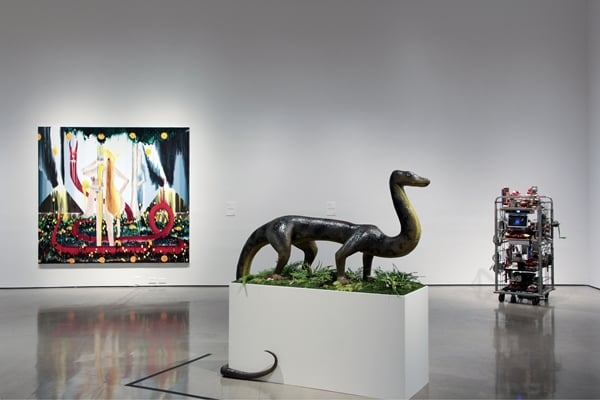
Photo: Gina Fuentes Walker.
MoBiA has organized a pretty and peculiar show.

Benjamin Sutton

If we’re going to get booted from paradise, let’s at least go out in style. This seems to be the overarching premise—aside from, you know, Christian origin myths—behind “Back to Eden,” independent curator Jennifer Scanlan’s exhibition at the Museum of Biblical Art (MoBiA), the museum housed in the American Bible Society’s Manhattan headquarters.
The show features works by 18 contemporary artists, including six pieces commissioned specifically for this exhibition, and two historical Bibles, all commenting on or evoking scenes or themes from the story in Genesis of how humans wound up getting kicked out of Eden. (For the unfamiliar, this crash course is helpful.)
The resulting thicket of thematic works is appropriately paradisiacal, by which I mean that the pieces on view are, for the most part, strikingly beautiful.
There’s also a palpable undercurrent of art with an environmentalist message, whether in pieces that dwell on humanity’s destruction of Earth or others that imagine utopian hybrids of man-made and natural elements.
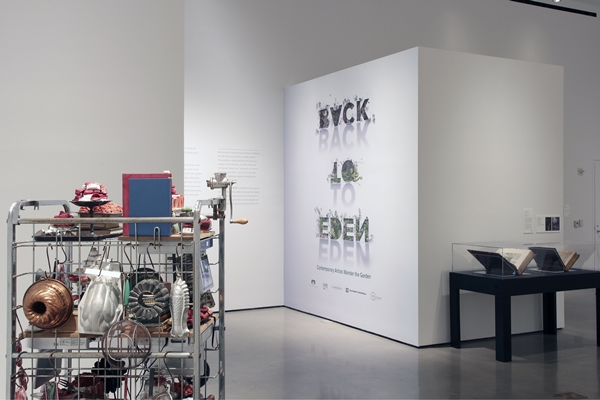
Installation view of “Back to Eden” at the Museum of Biblical Art.
Photo: Gina Fuentes Walker.
They are not hung according to any discernible logic, beyond the conspicuous grouping of all the snake art, but I found that tackling the exhibition in a narrative sequence from the creation of Earth through Adam and Eve’s expulsion from Eden brought out some of what makes this eclectic show amusing.
It doesn’t help explain why this curious show of Edenic artworks has been put together by MoBiA. But as Adam and Eve learned the hard way, sometimes you’re better off not knowing.
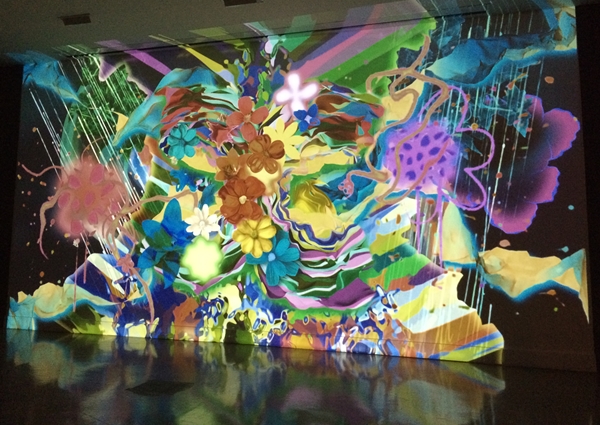
Sean Capone, 1000 Paths (To The Divine) (2014).
Courtesy of the artist. Photo: Benjamin Sutton.
CREATION
Leading off, both symbolically and, depending on where you enter, actually, Sean Capone’s projected animation 1000 Paths (To the Divine) (2014) is absolutely mesmerizing. Its cyclical, fluid, and floral patterns create psychedelic forms that nevertheless register as an abstracted fusion of the Big Bang and the biblical narrative of creation. In the opening sequence, a Pangea-like cluster of shapes grows apart, and two mighty rivers meet to create a giant ring, floating as if in zero gravity. These forces engender life, with plant-like organisms blooming and stretching across the wall-sized screen, and amoebic figures scurrying, fusing, and multiplying. It’s a very appropriate place to start, since Capone manages to evoke the beginning of, well, everything. You could easily bliss out in front of 1000 Paths for 1,000 minutes, but there’s much more deserving work to see.
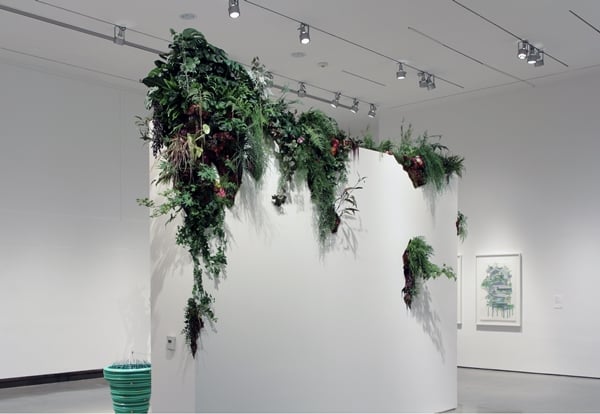
Lina Puerta, Matorral (2014).
Photo: Gina Fuentes Walker. Courtesy the artist.
THE GARDEN
Within the main gallery, verdant work is in full bloom. There are sub-themes to be spotted among the thickets (evocations of repressed memories and desires through imaginative uses of garden tools are a surprisingly prevalent strain), but shrubbery of all sorts has taken root throughout the space. The most seductive is Colombian-American sculptor Lina Puerta’s tumorous wall installation Matorral (2014), in which her trademark clusters of foam and moss wrapped in lacy, patterned fabric sprout ferns, beads, rhinestones, and feathers. They evoke the bounteous overgrowth of Eden’s flora, while also likening outmoded trappings of stereotypical feminine beauty to invasive species.

Barnaby Furnas, The Fruit Eaters (2013).
Courtesy the artist and Victoria Miro, London. Photo: Stephen White, © Barnaby Furnas.
ADAM AND EVE
Interestingly, none of the artists in “Back to Eden” render the original couple in their idyllic state—Barnaby Furnas comes closest in a dazzling painting of the moment Adam and Eve chow down on the forbidden fruit. This is all the more striking because the show’s two historic works, a Koberger Bible from Germany circa 1483 and England’s Matthews Bible from 1537, both feature the first couple enjoying prelapsarian life. The Matthews Bible in particular pictures Adam and Eve seated peacefully under a tree, surrounded by an improbably peaceful assortment of animals. The infinitely more Medieval Koberger Bible shows the couple about to transgress—in this version, the serpent has a woman’s head—and then being cast into the wilderness. The fact that contemporary artists have less facility for portraying human happiness than their Dark Ages forbears probably says something less-than-flattering about our culture’s current conditioning.
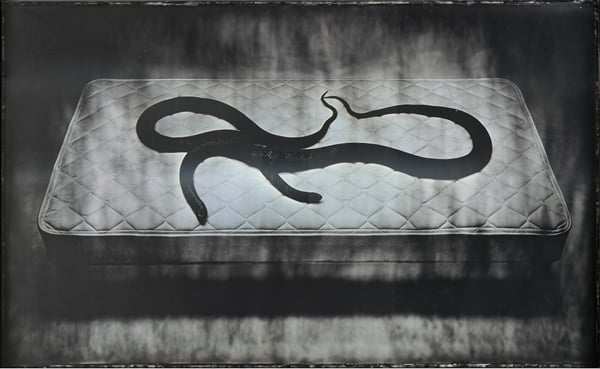
Adam Fuss, The Space Between Garden and Eve (2011).
Courtesy Cheim & Read, New York.
THE SNAKE
Maybe it’s appropriate that, just as Satan was the most compelling character in John Milton’s Paradise Lost, representations of the serpent make for some of the most compelling, complex, conflicting, and disappointing pieces in “Back to Eden.” Adam Fuss’s daguerreotype The Space Between Garden and Eve (2011), which shows two very large snakes entwined on a bare mattress, captures these symbolically charged animals in a domestic setting. The photo arrests you with its disjointed fusion of ominous, contemporary imagery rendered in an ancient medium.
Nearby, one of the show’s few missteps is Mat Collishaw’s East of Eden (2013). Inside its all-black Murano glass frame, behind a pane of tinted surveillance mirror, is a video of a snake writhing amid clouds of smoke, its glowing eyes ominously trained on the viewer. The piece is technically impressive and has an undeniable cool factor, but beyond its most obvious implication—that vanity is the defining sin of our time—I think it’s just smoke and mirrors.
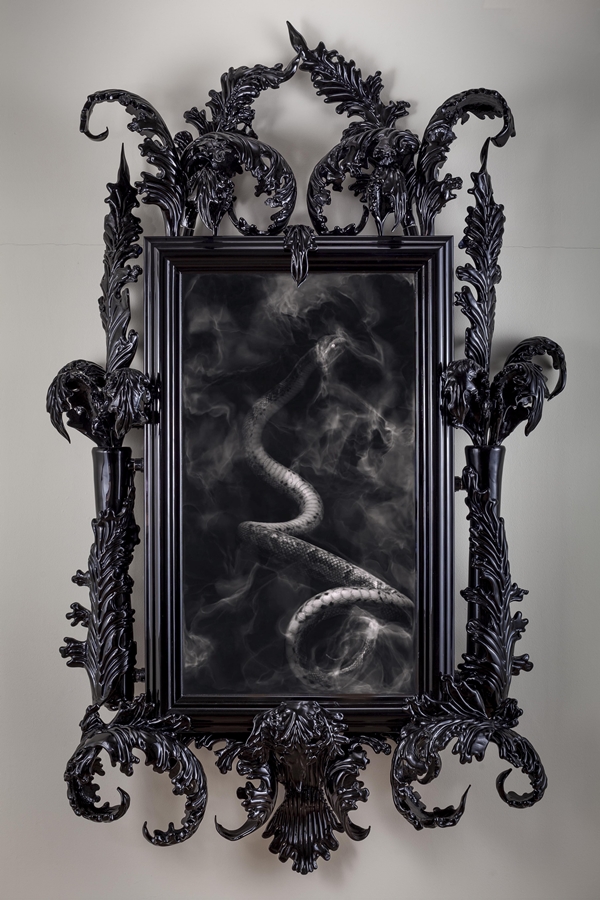
Mat Collishaw, East of Eden (2013).
Image courtesy of the artist and Blain Southern.
The piece that at first irked me the most, and that days later became one of my favorites as I continued to reflect on the exhibition, occupies the very center of the gallery. Mark Dion’s sculpture The Serpent Before the Fall (2014) literalizes the story that snakes used to walk on legs, but had the appendages taken away as punishment for the reptiles’ role in facilitating the Fall. Dion’s natural history museum-like display features a four-legged snake, its long tail reaching to the ground and partially encircling its podium. Amid all the sleek, self-serious, elegant, and ominous works, its humor marks a welcome change of tone.
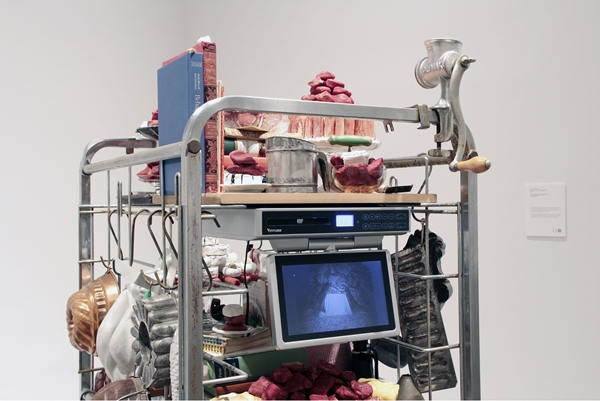
Dana Sherwood, Banquets in the Dark Wilderness (2014).
Photo: Gina Fuentes Walker. Courtesy the artist.
THE FALL
While there’s plenty of pre- and post-Fall work, only a couple of pieces depict the offending act itself. Barnaby Furnas’s massive The Fruit Eaters (2013) renders the moment Adam and Eve feast on the forbidden fruit in dripping, bold, and seductive tones. Furnas makes transgression look good. Meanwhile, Dana Sherwood’s sculptural video installation Banquets in the Dark Wilderness (2014) casts nocturnal critters as surrogate Adams and Eves. Like the Serpent, Sherwood set out irresistible spreads of food and then filmed as raccoons, opossums, and other animals indulged. The resulting installation features grotesque sculptures of faux pastries and ground meat in elaborate arrangements worthy of an exceptionally ravenous and carnivorous queen. These are set on a metal cart piled high with cookbooks, slaughterhouse utensils, and small video monitors showing the animals feasting.
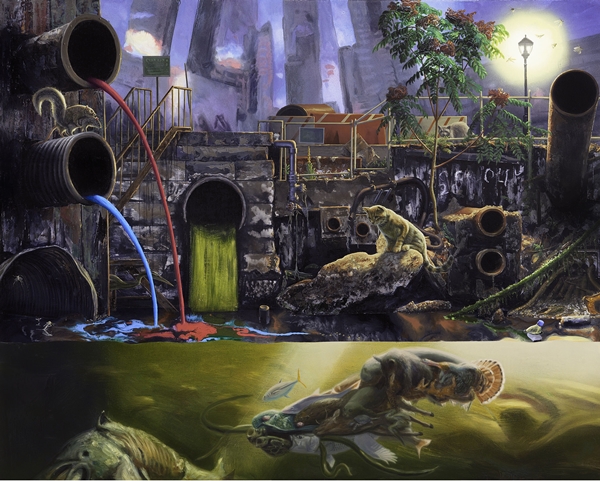
Alexis Rockman, Gowanus (2013).
Photo: © Alexis Rockman. Courtesy Sperone Westwater, New York.
THE EXPULSION
Animals also act out the next chapter of the biblical narrative in another of the show’s strongest works, Alexis Rockman’s engrossing painting Gowanus (2013). It juxtaposes the post-industrial squalor of that Brooklyn canal and Superfund site with a hybrid animal made up of about 20 extinct species lurking in the deep. This fantasy, admittedly more Melvillian than biblical, is rendered on a grand scale in lush detail and saturated tones. It juxtaposes an Edenic vision of seemingly antimonious creatures getting along—a throwback to the scene in the Matthews Bible—with a decidedly post-lapsarian landscape of toxic sludge.
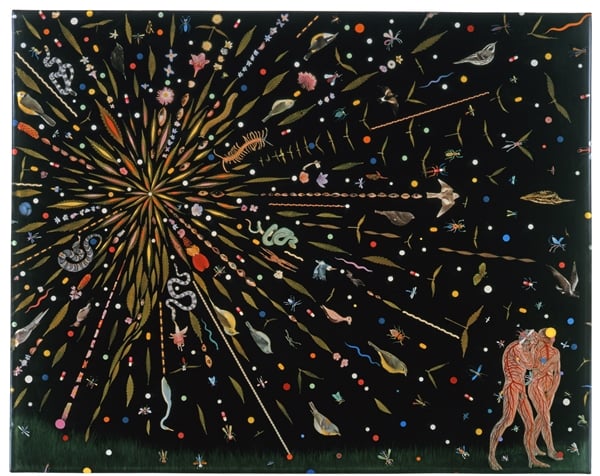
Fred Tomaselli, Study for Expulsion (2000).
Photo: © the artist. Courtesy James Cohan Gallery, New York/Shanghai.
PARADISE REGAINED?
Works like Rockman’s, Puerta’s, and Sherwood’s, or Marina Zurkow’s three-channel animation, Mesocosm (Times Square NY) (2014)—which offers up post-apocalypse Midtown as a new Eden, where packs of rats, wolves, and naked, dancing humans roam the streets—give the exhibition an edge that is in fact secular and environmentalist.
Many of the pieces in “Back to Eden” take up its biblical theme only to reiterate that the fall of man has nothing to do with a demonic snake, and everything to do with the greed of man. And if our own irresponsibility rather than bickering supernatural beings landed us in this mess, it should also be in our power to restore Eden. In the meantime, the recreational drugs encased in Fred Tomaselli’s resin collage Study for Expuslion (2000) offer a puckish solution for coping with life after the Fall.
“Back to Eden” continues at MoBiA through September 28.